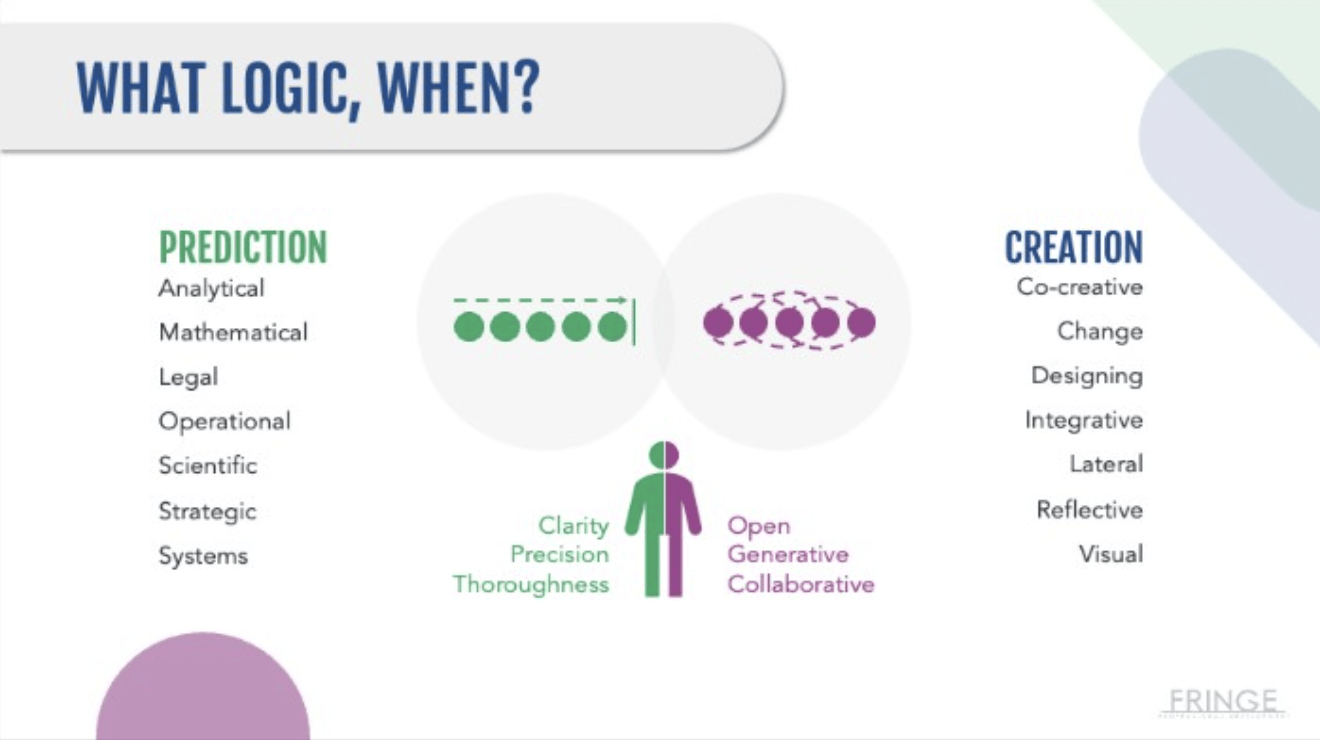Rachael Bosch is the CEO and founder at Fringe PD, where their mission is to help people communicate better and create more human workplaces.
Creativity is an incredibly powerful tool that has the potential to unlock solutions and new ideas in any workplace. After spending my early professional years steeped in the creative world, I came to law firms and was shocked by the fear, reluctance, and lack of credibility surrounding the creative process. All too often, traditional “linear” workplaces prioritize more logical, analytical thinking over creative approaches—leading many professional employees to feel like their creativity is not valued. Today, we are talking about how introducing creative thinking into a linear workplace can provide a massive benefit to businesses and employees. We’ll explore the positive outcomes of creative thinking and strategies for introducing it into a more structured environment. By tapping into the power of creativity, any organization can unlock new possibilities and create an environment where employees feel valued and inspired to do their best work. And the best part – no jazz hands required!
What do we mean by a “linear workplace”?
A linear workplace is one in which organization and decision-making take place along traditional, predictable lines. It typically involves a strict hierarchy, with decisions being made from the top down and with little room for creativity or deviation from existing rules. In this environment, employees are expected to follow instructions precisely and conform to established structures without room for innovation or creative expression.
OK, so how do we define creative thinking?
Creative thinking is a type of problem-solving process that involves generating, exploring, and testing ideas. It entails the use of imagination, intuition, divergent thinking skills, and out-of-the-box solutions to come up with original ideas or solve complex problems. Creative thinking encourages employees to think outside the box and come up with innovative solutions that can help the organization. Unlike linear thinking, which is more analytical and follows a structured process to reach a solution, creative thinking allows employees to come up with ideas without any predetermined parameters or restrictions. It encourages employees to be open-minded and think of unconventional solutions that might otherwise have gone unnoticed.
Most organizations benefit from a healthy mix of linear thinking (prediction logic) and creative thinking (creation logic) from their employees, but many still lean into one or the other. Organizations can gain advantages and unlock new possibilities by utilizing both types of thinking in the workplace. We have partnered with countless clients who have utilized the improvisation skills and the design thinking process taught in our Fringe workshops to bring creative thinking to their linear leaning teams, and the results have been phenomenal! Here’s why…

Benefits of Creative Thinking in a Linear Workplace
Increased motivation and morale
By introducing creative thinking into a linear workplace, employees can feel more inspired and motivated to do their best work. Creative thinking encourages employees to explore new ideas, test different approaches, and come up with innovative solutions. This allows employees to feel empowered in their work as they are given the opportunity to use their imagination and creativity. It also helps spark collaboration among employees as they can work together to brainstorm ideas and come up with creative solutions. When employees are given the freedom to think creatively, it creates an environment where they feel valued and inspired to do their best work.
Improved problem-solving skills
Creative thinking can also help improve problem-solving skills in the workplace. By introducing creative thinking into a linear workplace, employees are encouraged to use their imagination and come up with solutions that may not have been considered before. This helps employees develop new problem-solving techniques and become better equipped to tackle complex situations. Creative thinking can also give employees the opportunity to think outside the box and come up with creative solutions that can benefit the entire organization. This helps employees stay ahead by introducing new ideas or approaches while helping them become better problem-solvers. With improved problem-solving skills, organizations can be more agile, efficient, and productive.
Enhanced collaboration among co-workers
Creative thinking can also help enhance collaboration among co-workers in a linear workplace. Encouraging employees to think outside the box and develop innovative solutions allows them to work together to brainstorm ideas and collaborate on projects. This helps foster teamwork, communication, and trust (psychological safety FTW!) among employees as they are allowed to voice their opinions and work together to develop creative solutions. Creative thinking also helps create an open and supportive environment where employees feel more comfortable expressing their ideas and opinions without fear of criticism from their peers or superiors. This encourages collaboration between different departments, allowing them to collaborate better on projects and come up with creative solutions that can benefit the entire organization.
Increased creativity and innovation
Finally, I know this one may be obvious, but introducing creative thinking into the workplace can help increase creativity! Encouraging employees to explore new ideas and come up with unconventional solutions helps push boundaries and introduce new ways of thinking. This can help open up opportunities for an organization in ways they could never have imagined before. Creative thinking also helps foster a culture of innovation, where employees are encouraged to come up with creative solutions that can benefit the organization in the long run.
Hopefully, you’re on board by this point. So let’s tackle how to implement creative thinking into your linear workplace!
Tips for Implementing Creative Thinking in a Linear Workplace
1 – Encourage collaboration between co-workers
Collaboration is key when it comes to introducing creative thinking in the workplace. Open up communication between employees and encourage them to work together to brainstorm ideas and come up with creative solutions. Creative thinking requires employees to think outside the box and explore new ideas. Encourage employees to research and brainstorm together to come up with creative solutions to problems. Reward teams who work collaboratively to find unique or innovative ideas to ensure that employees feel valued and encouraged. Celebrate the WE, not the ME.
2 – Create an environment that encourages creative thinking
Create an environment that is conducive to creative thinking by encouraging open communication and collaboration between employees. Make sure to provide resources and training for employees so they can stay up-to-date with the latest problem-solving techniques and become better equipped to tackle complex situations. This also means creating space for people to be creative, a real obstacle in most fast-paced organizations. Creativity isn’t linear, so it doesn’t follow a standard pattern. Be sure you create the space needed to solve your gnarliest problems and don’t rush those timelines!
3 – Provide opportunities for employees to practice free-form expression of ideas
Give employees the opportunity to express their ideas freely during meetings and brainstorming sessions. This will help them become more comfortable exploring new concepts and expressing their creativity without feeling judged or criticized by their peers. It can also lead to greater collaboration between departments as they can work together to come up with creative solutions. One simple technique we teach is to make sure that all voices are heard in each meeting where brainstorming is taking place. Leaders, ensure you set this expectation at the top of the meeting, and if you haven’t heard from someone, invite them to share if they have anything to add.
4 – Establish a culture of innovation and risk-taking
This one can be scary for my more risk-averse friends. But, I promise, there are areas in your organization where taking small risks will have a positive impact on procedures and internal affairs and little impact on the bottom line. Creative thinking requires taking risks and exploring new ideas. Encourage employees to step out of their comfort zone and suggest unconventional solutions that could benefit the organization in the long run. This will help foster a culture of creativity and innovation, which is important for any successful organization. Make sure that employees have the necessary resources and training to come up with creative solutions. This can include providing access to technology, books, and other materials to help them think outside the box.
Creative thinking can be a powerful tool when it comes to increasing motivation, morale, and collaboration among employees. It helps open up opportunities for an organization as it allows them to explore potential markets or develop innovative products that can set them apart from their competitors. Furthermore, creative thinking helps foster a culture of innovation, where employees are encouraged to come up with creative solutions that can benefit the organization in the long run.
Organizations looking to introduce creative thinking into their workplace should encourage collaboration between co-workers, create an environment that encourages creative thinking, provide opportunities for employees to practice free-form expression of ideas, and establish a culture of innovation
If you’re looking for a way to spark creativity in your workplace, check out Fringe PD’s interactive workshops! Our experienced team of professionals will help your team create an environment that encourages creative thinking and collaboration among co-workers. With our customizable packages, you’ll be able to develop a plan that works best for you and your organization. Contact us today for more information!






